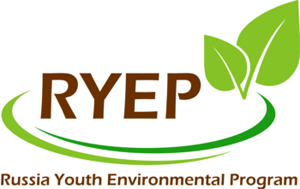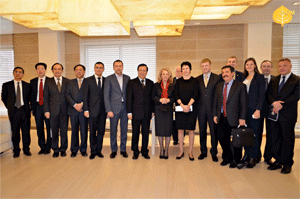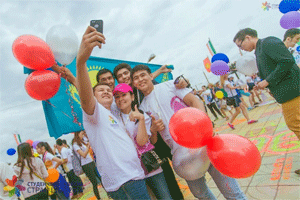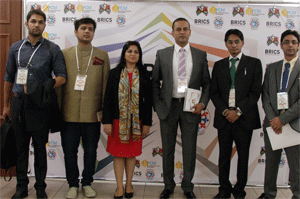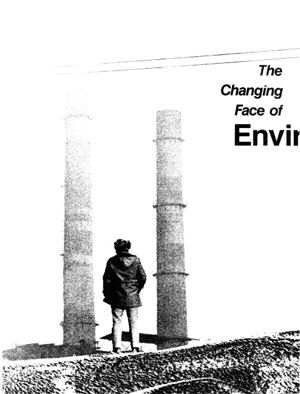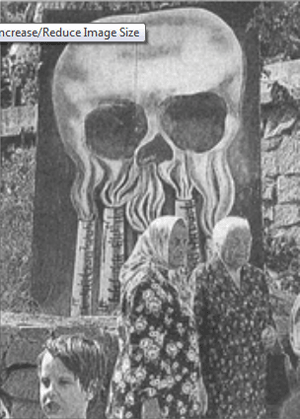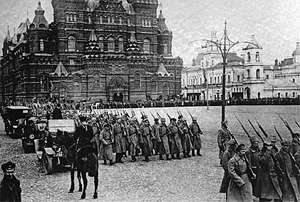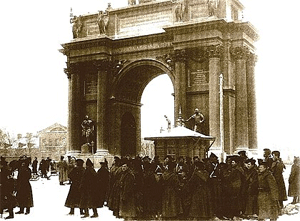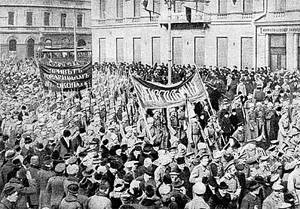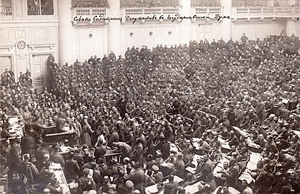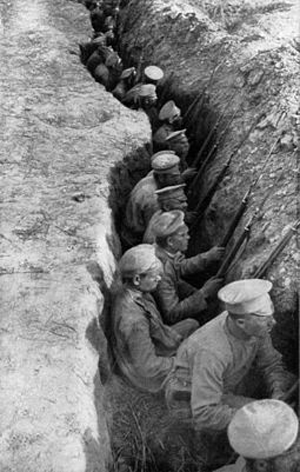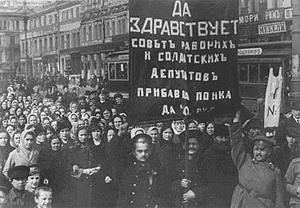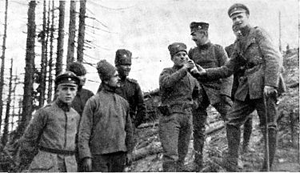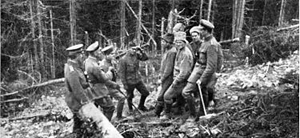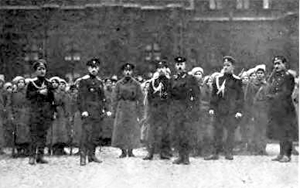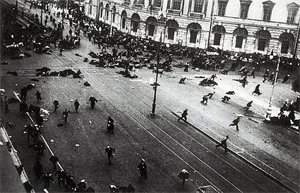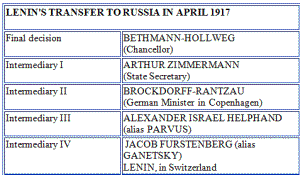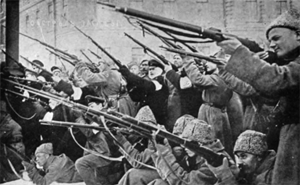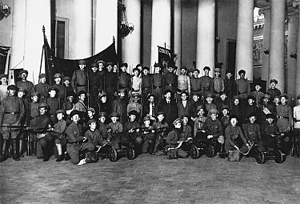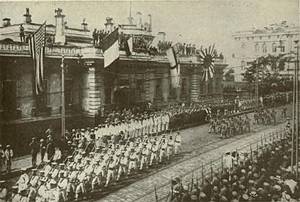by Viatcheslav Shuper and A.L. Valesyan
© CNRS-UMR Géographie-cités 8504
NOTICE: THIS WORK MAY BE PROTECTED BY COPYRIGHT
YOU ARE REQUIRED TO READ THE COPYRIGHT NOTICE AT THIS LINK BEFORE YOU READ THE FOLLOWING WORK, THAT IS AVAILABLE SOLELY FOR PRIVATE STUDY, SCHOLARSHIP OR RESEARCH PURSUANT TO 17 U.S.C. SECTION 107 AND 108. IN THE EVENT THAT THE LIBRARY DETERMINES THAT UNLAWFUL COPYING OF THIS WORK HAS OCCURRED, THE LIBRARY HAS THE RIGHT TO BLOCK THE I.P. ADDRESS AT WHICH THE UNLAWFUL COPYING APPEARED TO HAVE OCCURRED. THANK YOU FOR RESPECTING THE RIGHTS OF COPYRIGHT OWNERS.
Abstract
Postulates of W. Christallers central-place theory are discussed with an introduction of a new sixth postulats. Under consideration are specific cases of settlement systems which cannot be described by the apparatus of the classical central-place theory. It is shown that besides external causes responsible for the deformation of Christaller grid (anisotropy of the territory, etc.) there are some inner, immanent causes of it which have spontaneous nature. The paper formulates basics of the relativist version of the central-place theory, introduces notions of "the degree of stability of urban settlement systems" and “isostatic equilibrium" (as an attractor). It presents the results of analysis of the degree of stability of settlement systems of Estonia, Armenia, Georgia, and Central Russia. It is substantiated that it is possible to create a theory of the Great Unification by applying the synthetic approach to both the relativist central-place theory and phasic conceptions of spatial development.
1. In the basic work of W. Christaller (Christaller, 1966) the central-place theory did not achieve complete logical harmony. Christaller laid down the foundations of the central-place theory for he formulated the most essential of its basic principles and stimulated so far further research. The theory became axiomatic thus allowing to get non-trivial results using deduction in 1960s only with primary respect to the works of M. Dacey and his school (Dacey and al., 1974). Among the other researchers' works those of J. Parr (Parr, 1969 and 1978) have to be mentioned.
2. Numerous scholars' efforts have succeeded in formulating the basic postulates of this theory. Its first postulate is the one of the isotropy of space. The space in the central-place theory is equally permeable in every direction via the transport, homogenous with respect to the rural population density, natural environment, and the distribution of all possible resources; in other words it is absolutely homogenous except the distribution of urban population which is to be described by the theory itself.
3. The second postulate of the theory is the one of the infinity of space. No fragments can be isolated from the Christaller grid. If we denied the infinite spacial transmission of the grid we would inevitably perceive the edge effects the theory can neither take into account no describe. The very principles of the theory's construction would be violated along the edges of the central-place system thus the fourth postulats to be discussed below would not be implemented under any circumstances. The impossibility of an "isolated state" results from the second postulats of the centralplace theory.
4. The third postulate is the one of maximum compactness of the zones. According to this postulate the reason central-place systems make hexagonal grid is that the maximum compact geometrical figure is a circle, and a regular hexagon is the figure the most close to the circle geometrically which allows solid packing in the two-dimensional space. The question of validating the space structure of central-place systems was discussed in details by A. Losch (Losch, 1959) and, later on, in general form by B. Rodoman (Rodoman, 1970).
5. The fourth postulate - the optimization principle - stipulates the polymorphism of the central-place systems. The statement that these systems can exist in three versions i.e. with a K value of 3, K value of 4, and 7 is considered by both scientific and educational accounts of the theory. Under condition that K is equal 3 the optimum configuration of market areas is achieved (central places are located in the nodes of the hexagonal grid), and the number of central places serving the region is minimal. K = 4 provides for minimal distances between central places located in the middle points of hexagonal grid's ribs. K = 7 provides for 2 the best administrative division as each central place of the lower hierarchical tier is subordinated to only one central place of the next higher tier comparing with two for K = 4 or three for K = 3.
6. The very parameter K has been defined by many scholars and J. Parr in particular as the number of central places of the next lower hierarchical tier subordinated to one central place of a given tier, plus one. One can describe K parameter in a different way - as a number of zones of the next lower hierarchical tier subordinated to one central place of a given tier.
7. Under a strict approach the central places system with K = 7 should be considered a certain misunderstanding (Shuper, 1990). According to the fourth postulate no central-place systems with other Ks could exist either for no basic principle has been found for them to be implemented in their spatial structure.
8. The fifth postulate of the theory is the assumption of the "rational" behavior of consumers. It suggests that all goods and services are being acquired at the nearest of all central places where they are available. One should not think though that the phenomenon of multi-purposes trips is essential for the systems with the optimum configuration of market areas only (K = 3). It is assumed that in the central places system with K = 4 all trips are strictly hierarchical which does not occur in reality. The divergence between real trips and those strictly hierarchical can be perceived as another expression of the phenomenon of multipurposes trips.
9. Finally, the sixth postulate of the central-place theory formulated by V. A. Shuper suggests the constancy of the share (k) of the population of a given central place in the total population of the area being served by the place, for all hierarchical tiers.
10. The necessity to introduce this postulate is dictated by the paradox of k parameter (Shuper, 1984).
11. It is widely known that in reality Christaller grids are substantially deformed. Anisotropy of the territory provoked by both natural and anthropogenic factors cannot leave undestroyed the ideal pattern of hexagons. It is far less known about the inner characteristics of any settlement system as well as the grid itself responsible for the deformation of the latter. What are these characteristics?
Anisotropy /ˌænɪˈsɒtrəpi/, /ˌænaɪˈsɒtrəpi/ is the property of being directionally dependent, which implies different properties in different directions, as opposed to isotropy. It can be defined as a difference, when measured along different axes, in a material's physical or mechanical properties (absorbance, refractive index, conductivity, tensile strength, etc.) An example of anisotropy is light coming through a polarizer. Another is wood, which is easier to split along its grain than across it.
-- Anisotropy, by Wikipedia
12. If a central place at a tier m + 1 is located close enough to the central place of a higher tier m, or even m - 1, then the former does not have to possess all set of functions appropriate for that level: some goods and services can be acquired at the nearest central place of higher hierarchical tier. Additional profit including informational one which is being received by central places of lower hierarchical tiers due to their closeness to larger centers is unquestionable. Such a concentration is beneficial for a larger center as well for it can use resources of places of lower tiers for its own needs. One can argue that the use of potential of numerous satellites-cities is an important source of development of a large city for it does not require the population growth of the latter, and the whole system can "save" on this.
13. If some functions of places of lower tiers have been transferred to the principal center the same should happen to their populations as well in order to avoid additional costs of transportation. Under such conditions the value of K cannot be kept constant even within the same hierarchical tier.
14. Now let us examine the very characteristics of the grid which are responsible for its deformation. According to the fourth postulate of the theory each central place with its service zone is being divided equally between central places of higher tiers as the former is located at the boundary between their zones. Each central place of higher hierarchical tier controls so far zones of all places of lower tiers. That postulates that any central place can be located at an equal distance from central places of higher tiers with those places belonging to different levels and thus having different size. In real world it could have corresponded to the situation when a small or average-sized city which is located at the same distance from two larger cities would have been equally attracted to both of them even if one of them is 4 times bigger than the former, and the other is 16 or 64 times bigger. Can we imagine that in order to get goods and services available both in Moscow and Tver' residents of Klin which is situated half-way between these cities would be equally likely to go to Moscow and to Tver'?
15. Let us consider a Christaller grid with K = 4 and three tiers of hierarchy. It is obvious that the service zone of the center of the first and highest tier of hierarchy will include the whole hexagon. At the second hierarchical tier the service zone of the principal center being now one of central places of the second tier will include not halves but whole zones of the inner circle of third-tier places, thus making the principal centers zone significantly larger. Now let us consider including a fourth tier of hierarchy. Those forth-tier places being located at the borders of the shaded area will gravitate not to the principal center to get services of the second level but to the second-tier central places. They will "take" their service zones with them thus changing the boundaries of the principal center's zone of second-tier service. Further changes will occur if more tiers of hierarchy are to be included. This violates the main principle underlying a system of central places which follows from the third postulate of the theory - the principle of zones' congruence. If not only a zone's size depends upon the number of hierarchical tiers but the very same tier of hierarchy includes zones of different sizes, then the coefficient K becomes meaningless.
16. It has been shown so far that some immanent causes exist which contribute to the deformation of a Christaller grid. These deformations are not a result of some external factors like anisotrope of the territory but occur spontaneously according to internal regularities.
17. One of the results of the above-described process of deformation of a Christaller grid is a growth of an urban agglomeration surrounding a national or regional capital. Agglomerations so far are the most pronounced examples of concentration of urban settlement systems (except for the cases when spatial unevenness of settlements' distribution is due to unevenness of distribution of natural resources). Classical central-place theory being spatially expressed by the ideal Christaller grid does not allow for any concentration of population at all for it can result in irregularities of the grid itself. It will also result in the violation of the Beckmann-Parr's equation which was deduced from the grid's characteristics (Parr, 1969).
18. Thus a very important fact which nevertheless - to the best knowledge of the authors - has not been reflected by the literature on the central-place theory points out that formation of large urban agglomerations violates not only theoretically predicted proportions of distances between cities but also relative sizes of central places of different tiers of hierarchy.
19. As it was mentioned above, one of the postulates of the theory is that of constancy of K (with K being the share of a central place in the population of its service zone) for all tiers of hierarchy. Under condition of sharp deformations of a Christaller lattice the value of K cannot remain constant not only for different hierarchical tiers but for same tier's central places as well. Consequently one cannot apply the Beckmann-Parr equation which describes relationship between sizes of central places of neighboring tiers. Thus unevenness of spatial distribution of an urban settlement system resulting in the formation of large agglomerations represents a different side of the reality which in turn requires substantial changes to be included into the classical central-places theory to have it all explained.
20. There is at least one more phenomenon which cannot be explained by the classical central-place theory: the absence of precisely those places in some urban settlement systems which should have occupied second highest tier of hierarchy. Sometimes, but not always, such an effect is accompanied by a heavy condensation of central places' web around the principal center.
21. It has been shown so far that population distributions between tiers of the Christaller hierarchy when different from those predicted by the Beckmann-Parr equation simply cannot be considered by the classical theory. As a result the latter is unable to take into account interrelations between spatial organization of a central-place system and a distribution of population among different tiers of the same system. As opposed to the classical central-place theory the relativistic central place theory developed by V.A. Shuper is aimed at the very interrelation between spatial organization of a central places' system and population distribution among its hierarchical tiers.
22. One of the central concepts of the relativistic central-place theory is that of an isostatic equilibrium. The latter is precisely what allows to establish a functional dependency between spatial organization of urban settlements and distribution of population among different hierarchical tiers. Tiers of centralplace hierarchy are being classified into heavy and light ones according to the fact if they have population respectively larger or smaller than it was predicted (by the classical theory?). A question can arise, that is why there should be any discrepancies at all between observed and predicted populations of a hierarchical tier? The answer was given above - there are both internal characteristics and external factors allowing for the deformation of an ideal grid.
R[e][n]
K
R[e][n]
P[t][n]
=
P[e][n]
/
P[t][n]
KkKKKKK
R[e][n]
R[t][n]
R[t][n]
/
R[e][n]
= m-1
23. Under the condition that isostatic effects are being completely compensated for this parameter has a value of m - 1, where m - 1 is a number of hierarchical tiers in a central places 1 system minus the first tier represented by only one central place. A compliance with the parameter of isostatic equilibrium is the very characteristic of stability of an urban settlement system.
24. The notion about urban settlement systems as gravitating in their development toward a certain stable state with the latter defined as an isostatic equilibrium has also a certain philosophical meaning. It allows to think about such a state as some kind of an attractor. This introduction of the notion of an attractor is not a mere tribute to a fashionable parlance: if we can assume that a process is determined not by initial conditions but by a final state, then we suggest both the existence of the equifinality and a possibility of using different routes between the initial and final conditions, more precisely - between stages of the process which were defined as such conditions.
Equifinality is the principle that in open systems a given end state can be reached by many potential means. The term and concept is due to Hans Driesch, the developmental biologist, later applied by Ludwig von Bertalanffy, the founder of general systems theory, and by William T. Powers, the founder of perceptual control theory. Driesch and von Bertalanffy prefer this term, in contrast to "goal", in describing complex systems' similar or convergent behavior. Powers simply emphasised the flexibility of response, since it emphasizes that the same end state may be achieved via many different paths or trajectories. In closed systems, a direct cause-and-effect relationship exists between the initial condition and the final state of the system: When a computer's 'on' switch is pushed, the system powers up. Open systems (such as biological and social systems), however, operate quite differently. The idea of equifinality suggests that similar results may be achieved with different initial conditions and in many different ways.[1] This phenomenon has also been referred to as isotelesis[2] (from Greek ἴσος isos "equal" and τέλεσις telesis: "the intelligent direction of effort toward the achievement of an end") when in games involving superrationality.
-- Equifinality, by Wikipedia
25. The idea of equifinality of the development of largest cities has been known in the science since mid-60s (Haggett, 1983). It states that gigantic cities show much more of a resemblance with each other than do those small cities they have grown up from. Some difficult philosophical questions arise here: it can be supposed that moving to similar conditions require similarity of initial conditions and factors affecting it, or it can be assumed that it is determined by a certain "construction" such as a potential form which is to be revealed in the process of a system's development.
26. Such a teleology can be quite well explained scientifically and logically. For example, K. Popper has shown that Darwin's natural selection must have a future expediency as motive forces of evolution (Popper, 1982). In this case the expediency will reveal itself in the future only but it needs certain spendings today.
Teleology or finality is a reason or explanation for something in function of its end, purpose, or goal. It is derived from two Greek words: telos (end, goal, purpose) and logos (reason, explanation). A purpose that is imposed by a human use, such as that of a fork, is called extrinsic. Natural teleology, common in classical philosophy but controversial today, contends that natural entities also have intrinsic purposes, irrespective of human use or opinion. For instance, Aristotle claimed that an acorn's intrinsic telos is to become a fully grown oak tree.
Though ancient atomists rejected the notion of natural teleology, teleological accounts of non-personal or non-human nature were explored and often endorsed in ancient and medieval philosophies, but fell into disfavor during the modern era (1600–1900). In the late 18th century, Immanuel Kant used the concept of telos as a regulative principle in his Critique of Judgment. Teleology was also fundamental to the speculative philosophy of Georg Hegel.
Contemporary philosophers and scientists are still discussing whether teleological axioms are useful or accurate in proposing modern philosophies and scientific theories. For instance, in 2012, Thomas Nagel proposed a non-Darwinian account of evolution that incorporates impersonal and natural teleological laws to explain the existence of life, consciousness, rationality, and objective value.
27. The very same approach is being applied in this research for there is yet no clear understanding of mechanisms determining development of settlement systems. Our knowledge allows to analyze past development of settlement systems but prohibits from formulating any analytical laws allowing to predict future states of these systems. That is why the notion of isostatic equilibrium as an attractor for the development of urban settlement systems possesses a few clear advantages. It happens because the most stable state and directions for the process are given with the latter always aiming to reach the former even if the system has diverged from the most stable state under the influence of external factors.
28. An important question has to be raised on the correlation between the classical and relativistic central-place theories. Let us consider this correlation from the position of I.V. Kuznetzov who formulated a partial principle of correspondence as follows:
29. "A new theory's mathematical apparatus containing a certain characteristic parameter which values are different in the old and new areas of phenomena passes to the old theory's mathematical apparatus with a proper value of the characteristic parameter" ("Principe...", 1979).
30. It seems obvious that such a characteristic parameter connecting the classical and relativistic theories is represented by the Beckmann-Parr equation. The very parameter K becoming meaningless under strong relativistic effects transform the apparatus of the classical theory into the relativistic one.
31. Another important factor determining the correspondence between the classical and relativistic theories is presented by the existence of a certain transitional zone where relativistic effects take place. Relativistic effects gradually penetrate into the classical theory: there are two poles. Firstly, the ideal Christaller grid described by the classical theory and the central-place system with no second hierarchical tier. The latter does not fit to the classical theory at all and can only be described by the relativistic theory. There is a wide "area" between those poles which includes the vast majority of urban settlement systems existing now or existed before.
32. It is obvious that a close-to-ideal Christaller grid can exist in a very rare situation. This is true even for the central places' system of South Germany. A corresponding figure in the classical book by W. Christaller (Christaller, 1966) unequivocally shows that only the existence of a preconceived idea let its author to see on the map something looking like a regular hexagonal grid.
33. Finally, the very state of isostatic equilibrium expressed by the equation (1) represents a very important parameter which ensures the correspondence between the classical and relativistic theories. If isostatic equilibrium is complete, then the equation (1) is true for both an urban system completely corresponding to the ideal Christaller grid (if one can imagine that such a system exists) and one with high concentration of cities near the principal center and no second hierarchical tier.
34. Let us now discuss stability of spatial structures of real settlement systems. It has to be emphasized that hierarchical structuralization of urban settlement systens does not happen at once. A hypothesis was earlier suggested by V.A. Shuper that urban settlement systems first had been formed as a whole while their compliance with predictions of the Zipf's rule getting improved, and then a distinct hierarchical structure was formed thus improving their agreement with predictions of the central-place theory and worsening their compliance with ones of the Zipf's rule.
35. As if substances pass with time from amorphous to crystalline conditions, settlement systems also pass from a quasi-amorphus state described by the Zipf's rule to a quasi-crystalline state characterized by predictions of the central-place theory.
36. This hypothesis has been successfully proved by such diverse settlement systems as those of Estonia, Armenia, Georgia and Central Russia (computing programs were created by N. Aznauryan).
37. Table 1 presents values of a parameter which was calculated using the method by Yu.V. Medvedkov (Medvedkov, 1964) and is equal to the average of squared deviations from the natural logarithm function approximating the population distribution of first 16 largest cities for corresponding regions. As it can be seen from the Table 1, all four settlement systems began improving their agreement with the Zipf's model during some initial period and then changed this trend to the opposite one. Increasing values of the parameter can be seen as an indicator of growing integrity of each system.
38. It seems to be quite logical that in Central Russia, transition from a quasi-amorphus state into a quasi-crystalline one happened as early as in the middle of nineteenth century. The following dynamics of the parameter show a constant growth. By the time when Estonian Republic proclaimed itself independent and left Russia Estonian settlement system had been already quite mature. Not surprisingly the latter had developed as a kind of integrity earlier than Armenia and Georgia did it. Being more compact than its northern neighbor, Armenia left Georgia behind for the latter was witnessing clear centrifugal tendencies. The latest decline of the parameter in Estonia might be understood as a legitimate fluctuation provoked by the process of re-establishing its independence.
39. Let us now analyze dynamics of the parameter which characterizes the degree of correspondence of a system with the state of isostatic equilibrium (Table 2).
40. In the case of Estonia, the parameter under consideration got quite close to its predicted value of 3 (for 4 tiers of hierarchy) by the year 1959, and in 1965 it became equal with the ideal. The subsequent behavior of the parameter can be interpreted as follows: under the forces of inertia of its own movement, the system achieves the value of 3.18, and after that it starts moving back. The hypothesis on oscillatory type of dynamics of the parameter has been already suggested (Valesyan, 1991). To obtain the data supporting such a hypothesis, we have to analyze many examples of real settlement systems.
41. A new splash occurring in Estonian settlement system after 1989 might seem quite strange. But we should not forget about stormy political collisions survived by Estonia during the period of painful re-establishing of its national independence, for they for sure influence the development of its urban settlement system.
Years / Central Russia / Estonia / Armenia / Georgia
1833 / 11.40 / -- / -- / --
1840 / 9.93 / -- / -- / --
1847 / 10.11 / -- / -- / --
1861 / 11.24 / -- / -- / --
1870 / 20.41 / -- / -- / --
1885 / 25.64 / -- / -- / --
1897 / 32.69 / -- / -- / --
1926 / -- / -- / 3.17 / 7.59
1927 / 1.49 / -- / -- / --
1931 / -- / -- / 6.62 / --
1934 / -- / 0.66 / -- / --
1939 / -- / -- / 6.32 / 16.51
1950 / -- / -- / -- / 16.25
1959 / -- / 3.36 / 15.09 / 19.04
1970 / -- / 4.22 / 22.21 / 21.60
1979 / -- / 5.98 / 28.42 / 23.47
1989 / -- / 7.61 / 36.66 . 28.00
1992 / 294.93 / 6.98 / -- / --
1993 / -- / -- / 37.11 / --
Table 1. Changes in the degree of agreement of some settlement systems with the rule of "rank-size".
Years / CentralRussia / Estonia / Armenia / Georgia
1926 / 2.01 (4) / -- / 3.11 (3) / 1.76 (4)
1927 / -- / 2.58 (3) / -- / --
1931 / -- / -- / -- / 1.73 (4)
1934 / -- / 2.40 (3) / -- / --
1937 / 2.41 (4) / -- / -- / --
1939 / -- / -- / 1.61 (3) / 1.92 (4)
1959 / 2.82(4) / 2.84 (4) / 1.55 (3) / 2.79 (4)
1965 / 3.07 (4) / 3.00 (4) / 2.33 (4) / 2.95 (4)
1970 / 3.32 (4) / 3.09 (4) / 2.68 (4) / 3.05 (4)
1979 / 3.63 (4) / 3.14 (4) / 2.99 (4) / 2.82 (4)
1985 / -- / 3.18 (4) / -- / --
1988 / -- / -- / 3.22 (4) / --
1989 / 3.55 (4) / 3.13 (4) / 3.14 (4) / 2.90 (4)
1992 / 3.57 (4) / 3.18 (4) / -- / --
1993 / -- / -- / 3.37 (4) / --
Table 2. Changes in the degree of spatial stabilite of some urban settlement systems.
Numbers in parentheses represent the number of hierarchical tiers.
42. As if on purpose, Estonia has been created by nature to help verify different approaches in the field of central-place theory. Settlement systems which lack the same degree of maturity and integrity fit this goal to a much lesser extent. Nevertheless an attempt to apply either classical or relativistic central-place theories to them can be quite interesting.
43. The only one of three Baltic republics, Estonia is an ideal region for the development of the central-place theory. Latvia's capital, Riga, is too big for such a country for the city became a major transportational center; Lithuania historically possesses two capitals. Both Ukraine and Byelorussia as if have been built of two distinctive pieces: their settlement systems are far from integrity, and this affects proportions of these systems. There are two capitals in Ukraine as well; in Byelorussia the urban settlement system is not only divided into eastern and western parts but also has disproportional hierarchical tiers: it lacks, in particular, a sufficient development of a network of small cities which would have contributed to the forth hierarchical tier.
44. In this connection republics of Caucasia are of a great interest, and especially those of Armenia and Georgia, as the territory of Azerbaijan has been torn apart. Let us consider the data on Armenia. As it can be seen from the Table 2, changes in the degree of stability of spatial structure of the urban settlement system in Armenia have been following the trend similar to one of Estonia: at the beginning there was a poor agreement with predictions of the theory, but since approximately mid-sixties, when a fourth hierarchical tier appeared in the system, the latter began to get closer to the isostatic equilibrium and even passed it "farther". Unlike Estonia, with its more mature settlement system, Armenia has not seen any returning movement of the "pendulum" yet, and the 1989 value reflects the impact of the major earthquake on its settlement system. It can be suggested that in the near future such a oscillatory trend will show up in Armenia as well.
45. A somewhat different trajectory describes the changes in the degree of spatial stability of the settlement system of Georgia. Having reached the isostatic equilibrium by the end of 1960s, the parameter of stability went to the opposite direction after that. For now it is hard to say if the settlement system of Georgia follows its own way, or it will repeat that of Estonia in a few years, with the parameter of stability decreasing after having reached an ideal agreement with the theory. If the second option comes true, its later realization can be explained by the lower level of integrity of the settlement system of Georgia: centrifugal tendencies could and still can be seen in it quite clearly.
Centrifugal: proceeding or acting in a direction away from a center or axis.
-- Centrifugal, by Merriam-Webster
46. Though all three settlement systems under consideration can be described by the classical central-place theory, it is not the case for the territory of Central Russia. The settlement system of Central Russia lacks those cities which had to have formed the second tier of hierarchy, that is why in order to evaluate the degree of agreement of the system with the isostatic equilibrium, we use the apparatus of the relativistic central-place theory.
R[t][n]
t/
R[e][n]
47. Let us shift our attention from real values of the parameter of stability of settlement systems to its methodological importance. At a first approximation, the latter can be used as a good indicator of changes in stages of spatial evolution of settlement. A hypothesis on the oscillatory nature of changes in urban settlement systems' stability was suggested earlier (Valesyan, 1991). The time points where the direction of oscillatory movements changes may turn out to be the very critical points where the system moves from one state with, for example, predominantly centripetal tendencies, to the other state with predominantly centrifugal ones. Monitoring trajectories of changes in stability of settlement systems with different level of maturity, together with studying spatial evolution of urbanisation in those systems, can lead to quite fruitful results.
48. We have analyzed some possibilities of synthesis of those conceptions which deal with settlement systems only. The search for these possibilities seems to be quite logical. It might be a lot less trivial of an idea to suggest the existence of a certain synchronisa in the changes of stages which describe heterogeneous spatial phenomena. An inner connection can exist between, say, an appearance of a new topological level in the transportation network, development of a new hierarchical tier in the corresponding urban settlement system, a change in directions of spatial components of urbanisation (from centripetal to centrifugal and vise versa) and an emergence of a next wave of concentration or deconcentration in the regional development. If enough of serious evidence could be found to support this statement, it would be possible to discuss possibilities to create a theory which would allow to embrace all existing conceptions of phasic spatial development. By analogy with physics, this future theory can be named with some sense of humor a theory of the Great Unification. The idea to create such a theory capable of unifying research paradigms which are methodologically related but still significantly separated from each other, will allow to reach a better understanding of the drama of spatial connections of different phenomena and to reveal their concordance.
In mathematics, topology (from the Greek τόπος, place, and λόγος, study) is concerned with the properties of space that are preserved under continuous deformations, such as stretching, crumpling and bending, but not tearing or gluing. This can be studied by considering a collection of subsets, called open sets, that satisfy certain properties, turning the given set into what is known as a topological space. Important topological properties include connectedness and compactness.
-- Topology, by Wikipedia
49. At a first approximation, we can intuitively suggest that the invariant which characterizes the degree of stability of spatial structure of urban settlement systems can become such a pivot to "thread" the above-named conceptions. This means that determining the trajectory of changes in stability of a system, a researcher can "catch" different stages of spatial self-development. It seems to have a deep meaning for the urban settlement system of a given region, reflects in one way or another a whole palette of the spatial self-development "from geology (location of largest cities at morpho-structural nodes) to ideology (cities as focuses of political and cultural life)" (Guberman, 1987).
50. Suggesting the above-named invariant as one of foundation-stones of the future theory of the Great Unification is a logical step from the methodological point of view, for the growth of the theoretical knowledge in any areas of the natural science starts from the search for specific invariants, or parameters which are stable with regard to certain transformations (Ovchinnikov & Shuper, 1987).
51. It might seem at the first sight that the suggested idea on the possibility to create the theory of the Great Unification is somewhat improbable or even fantastic. But it is known that the verisimilitude is a false criterion of the correctness of a theory.
52. Strict mathematical statements existing in the theory will allow to empirically verify its conclusions in the future. As it was noted by K. Popper, "we try to find similar features in objects and interpret them according to laws invented by ourselves. Not waiting for all premises to be at our disposal, we immediately formulate conclusions. They can be rejected later on if the observation will prove their error" (Popper, 1959).
53. As a conclusion, let us express the hope that the theory of the Great Unification will not lack attention of geographers. For if a conception, as it was righteously noticed by W. Heisenberg, "is so good that it allows to combine a lot of most different phenomena which look "the same" or closely related in a certain aspect, then this conception will be accepted for the very unifying power of its own" (Heisenberg, 1991, p.77).
_______________
Bibliography
Christaller, W., 1966,Central Places in Southern Germany,Englewood Cliffs (N.J.),Prentice-Hall.
Dacey, M.F., Davies, O., Flowerdeco, R., Huff, J., Ko, A., Pipkin, & John S., 1974, "One Dimensional Central Place Theory", Evanston (Ill.), Dept. of Geography, Northwestern University, n°21-1974.
Funck, R. & Parr, J.B. (ed.), 1978, The Analysis of Regional Structure : Essays in honor of AugustLosch, Pion, London.
Guberman, Sh.A., 1987, "O Priurochennosti Krupneyshikh Gorodov Mira k Diskretnym Shirotam [On the Location of Biggest Cities in the World at "Discrete" Latitudes]", in Metody Izucheniya Rasseleniya, Moscow, 100-107.
Haggett, P., 1983,Geography : A Modern Synthesis,Rev. 3rd ed., New York, Harper & Row.
Heisenberg, W., 1991, "Chto Takoye "Ponimaniye" v Teoreticheskoy Fizike ?" [What is "Understanding" in Theoretical Physics ?]", in Priroda, n°4-1991, pp.75-77.
Losch, August, 1954,The Economics of Location,New Haven, Yale University Press.
Medvedkov, Yu.V., 1964, "O Razmerakh Gorodov, Ob'edinennykh v Systemu [on the Sizes of Cities Being Included into a System]", in Kolichestvenniye Metody Issledovaniya v Ekonomicheskoy Geographii, Moscow, 90-121.
Ovchinnikov, N.F. & Shuper, V.A., 1987, "Symmetria Sotsial'no-Geographicheskogo Prostranstva i Samoorganizatsia System Rasseleniya [Symmetry of Social Geographic Space and Selforganization of Settlement Systems, in Metody Izuchenia Rasseleniya, Moscow, 18-34.
Parr, J.B., 1969, "City Hierarchies and the Distribution of City Size : A Reconsideration of Beckmann's Contribution", Journal ofRegionalscience, vol. 9, n°2-1969, 239-253.
DOI : 10.1111/j.1467-9787.1969.tb01337.x
Parr, J.B., 1978, "Models of the Central Place System : A More General Approach", Urban Studies, n°1-1978, 35-49.
DOI : 10.1080/00420987820080041
Popper, K.R.,1976,Unended Quest : An Intellectual Autobiography,London, Fontana.
Popper, K.R., 1959, The Logic of Scientific Discovery, New York, BasicBooks.
DOI : 10.1063/1.3060577
Printsip Sootvetstviya. Istoriko-metodologicheskii analiz [Principle of Correspondence. Historical Methodological Analysis], Moscow, 1979.
Rodoman, B.B., 1970, "Osnovniye Protsessy Prostranstvennoi Differentsiatsii [Major Processes of Spatial Differentiation]", Vestnik MGU, Seriya V. Geographiya, n°5-1970, pp.22-30.
Shuper, V.A., 1984, "Paradoksy Teorii Tsentral'nykh Mest i Ikh Znachenie Dlya Analiza System Rasseleniya Stolichnogo Tipa [Paradoxes of Central Place Theory and Their Importance for the
Analysis of Settlement Systems of Regional Capitals]", in Regional Settlement in the USSR, Moscow, 172-184.
Shuper, V.A., 1989, "Deformation of Central Place Systems in the Formation of Large Urban Agglomerations", Soviet Geography, XXX, n°1-1989, 24-32.
Shuper, V.A., 1989, "Nekotoriye Udivitellniye Svoystva Kristallerovskikh Reshetok [Some Amazing Characteristics of Christaller Grids]", Izvestiya AN, Seriya geographicheskaya, n°1-1990, 96-100.
Valesyan, A.L., 1991, "Kolebatel'niye Protsessy v Systemakh Tsentral'nykh Mest [Oscillatory Processes in Central Place Systems]", Izvestiya VGO, 123, n°4-1991, 371-372.
List of illustrations
URL http://journals.openedition.org/cyberge ... /img-1.png
URL http://journals.openedition.org/cyberge ... /img-2.png
URL http://journals.openedition.org/cyberge ... /img-3.png
URL http://journals.openedition.org/cyberge ... /img-4.png
URL http://journals.openedition.org/cyberge ... /img-5.png
URL http://journals.openedition.org/cyberge ... /img-6.png
URL http://journals.openedition.org/cyberge ... /img-7.png
URL http://journals.openedition.org/cyberge ... /img-8.png
URL http://journals.openedition.org/cyberge ... /img-9.png
URL http://journals.openedition.org/cyberge ... img-10.png
URL http://journals.openedition.org/cyberge ... img-11.png
URL http://journals.openedition.org/cyberge ... img-12.png
URL http://journals.openedition.org/cyberge ... img-13.png
URL http://journals.openedition.org/cyberge ... img-14.png
URL http://journals.openedition.org/cyberge ... img-15.png
URL http://journals.openedition.org/cyberge ... img-16.png
URL http://journals.openedition.org/cyberge ... img-17.png
URL http://journals.openedition.org/cyberge ... img-18.png
URL http://journals.openedition.org/cyberge ... img-19.png
URL http://journals.openedition.org/cyberge ... img-20.png
URL http://journals.openedition.org/cyberge ... img-21.png
URL http://journals.openedition.org/cyberge ... img-22.png
URL http://journals.openedition.org/cyberge ... img-23.png
References
Electronic reference
Viatcheslav Shuper and A.L. Valesyan, « Spatial structure of urban settlement systems : stability versus changeability », Cybergeo : European Journal of Geography [Online], Systems, Modelling, Geostatistics, document 88, Online since 26 March 1999, connection on 03 September 2018. URL : http://journals.openedition.org/cybergeo/2386 ; DOI : 10.4000/cybergeo.2386
About the authors
Viatcheslav Shuper
Institut de Géographie, Académie des Sciences de Russie, Moscou
By this author
Débats socratiques en géographie [Full text]
СОКРАТИЧЕСКИЕ ЧТЕНИЯ ПО ГЕОГРАФИИ
Published in Cybergeo : European Journal of Geography, Current issues, Débats socratiques en géographie
La théorie des lieux centraux et les phénomènes d’évolution [Full text]
Article 87
Published in Cybergeo : European Journal of Geography, Systems, Modelling, Geostatistics
A.L. Valesyan
Institut de Géographie
Académie des Sciences de Russie, Moscou

